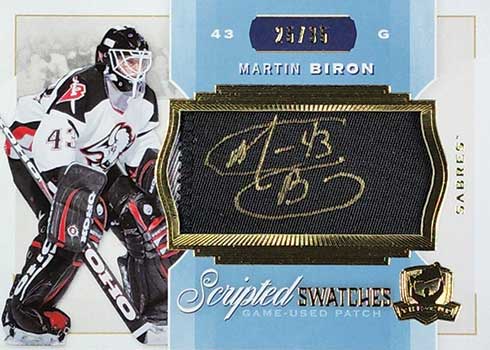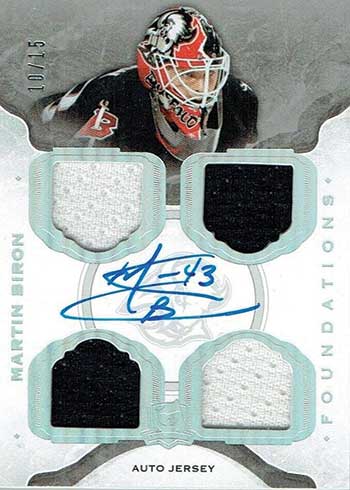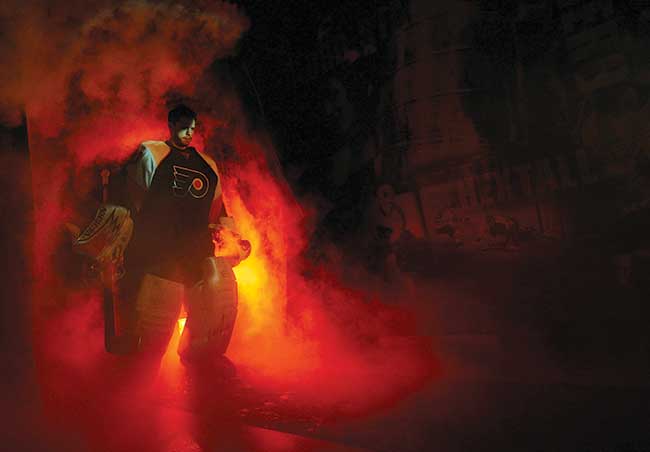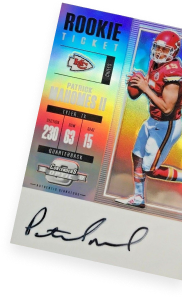In Conversation: Martin Biron
When Martin Biron reached the NHL in 1995, his father, Rejean, started an ambitious project to collect all of his son’s cards.
“Well, it didn’t take long before he realized that’s impossible to do because there’s so many different kind of cards,” Biron laughed.
Trying to track down hundreds of singles illustrated how much the hobby had grown since Biron played with his O-Pee-Chee cards while growing up in Quebec City.
To learn more about collecting, the Birons often consulted this magazine for help.
“We would always look in the Beckett (to see) how many cards there were (and) the value,” Biron said. “So that’s when … I got the first idea of what this is all about and also realized, ‘Man, this is a whole world of collectibles that’s pretty significant.’”

These days, the loquacious Biron is a popular broadcaster for the Buffalo Sabres, his first NHL team. Nationally, he’s a regular on TSN and Sirius XM’s NHL Network. But even in his mid-40s, he takes simple pleasure in the stories hockey cards can tell and the memories they conjure of his 16-year career.
Beckett: Were you a collector as a kid?
Biron: We did buy a lot of packs. I can’t say I was a collector because most of the cards we got it was (to) read the stats. My parents had Quebec Nordiques season tickets, so if the Hartford Whalers were in town and Mike Liut was playing that night, I’d (find his cards) and I’d read the stats and take a look at the pictures. That’s how I associated the player with who they were. So they became significantly used after a while. They weren’t in Mint condition.
And then (another) thing we would do is (play) floor hockey with them. I’d set up two nets on the hardwood floor, I’d have the puck from table hockey, and then I’d use the cards as the players. So I can’t say I was a collector because they were toys for me.

Beckett: What are your most vivid memories of the Nordiques growing up?
Biron: They used to have one or two open practices a year, and one time we were sitting maybe 10, 12 rows up (in Le Colisée) and Robbie Ftorek pointed to me and said, “Hey kid, kid, come down.” I was maybe four or five years old, so my dad brought me down to the glass and Robbie Ftorek gave me a puck. And then after practice … we took a picture and he gave me a stick.
And again, this is how we weren’t very into collector’s items. Later that year we were skating in the backyard, I took the puck with me out there and lost it. My dad broke his stick in a men’s league game and he’s like, “I’ll grab this stick as my spare,” and then he used it and it was a really good stick. Obviously, NHL sticks were better than the sticks we bought at Canadian Tire back home, right? So he really liked the stick, and two games later he broke it.
So for me, those moments were more important than the actual collector’s items.
I remember going to the airport or the (train station) in Quebec City after they beat Montreal in the playoffs and taking pictures with Mario Gosselin, the goaltender, (and) Michel Goulet, and Real “Buddy” Cloutier. (He) was from the next town over from us, that’s where he grew up. And I got pictures with the Stastnys (and) Dale Hunter. Yeah, we were nuts, but it was more about the connection to the players, and getting a handshake or a picture. We were crazy fans.

Beckett: Do you have any Nordiques memorabilia left from your childhood?
Biron: I have a Cloutier jersey that’s kid’s-sized. And the funny thing about it is instead of saying ‘Cloutier’ on the back, the name tag says ‘Buddy,’ because that was his nickname. When I was a kid, I would wear that thing everywhere.
Beckett: So eventually your career progressed and you became the player that others collected. Do you remember seeing your first cards?
Biron: The (1995-96 Classic Draft Picks #16) is one of the first that came out. I have the clear throat guard with the (number) 00 on it. My glove position is so bad it’s like I’m holding a pizza box or whatever. I remember seeing it leading into my draft year and it was really cool. And I remember going to the flea market the next summer and seeing that card, and there were different variations of it – one had gold, one was just clear, whatever. I remember seeing one of the different variations in a stack of cards and buying it for a quarter. And I remember going back to the car with my parents and saying, “If he knew that was my card, he probably would’ve charged me a dollar or something!”
There’s (one) card that I think is really special. It’s the (1996-97 Pinnacle #224) where I have the number 35, and it’s against the St. Louis Blues and it’s at the Aud in Buffalo in training camp in ‘95.
That was a preseason game, the only preseason game I played that year. And I’m on my knees and looking over my shoulders as a shot went high and wide over my glove.

Sometimes someone will ask me, “Why did you have number 35?” And I’m like, “Because it was training camp. You get whatever number they give you, right?” I mean, one day you’re 35, the next day you’re 1, the next day you’re 30. I don’t know. I got a jersey and I was in a game. But I remember that specific card for the picture being taken in my very first preseason game.
Beckett: You were the last NHL player to wear 00. Why did you sport that number?
Biron: During my Midget AAA year, I played in a town called Amos (in Northern Quebec). And I make the team and they’re like, “OK, here are the goalie numbers.” It was 00, 30 and 33. Those are the three goalie-cut jerseys they have. So me and the other goalie put the three numbers in a hat. And I knew I didn’t want 33 (because) I hated the Canadiens and I hated Patrick Roy for that matter, so there’s no way I’m wearing 33 like Patrick. And I ended up picking 00.
So I wore it that year and had a really good season. Ended up being goalie of the year, got drafted into the (Quebec Major Junior Hockey League) in the first round. I went to Beauport and asked if I could keep the number and I had another really good year. And I kept it going until my first year in Rochester, where as a rookie in the pros they were like, “You don’t get to pick your number, we give you your number.” So they gave me No. 1, which I hated. And by the time I was full-time in the NHL they had made the rule change that I couldn’t use 00, but I got to play a few games with it because Jim Pizzutelli, who was the athletic trainer with the Sabres, and Rip Simonik, the equipment manager, were like, “We’re giving the kid 00.” So when I got to Pittsburgh for my first NHL game, they had my 00 jersey made up. They were the ones that allowed me to wear it.
Beckett: Injuries forced the Sabres to briefly recall you from junior during the 1995-96 season just months after they drafted you 16th overall.You made your NHL debut as an 18-year-old against Mario Lemieux and Jaromir Jagr in Pittsburgh, and you played in the MemorialAuditorium and the Montreal Forum shortly before those legendary buildings closed. What was the experience like of playing in the NHL at such a young age?
Biron: It was pretty surreal. There’s a little backstory to it, because in mid-December of 1995, I’m in Campbellton, New Brunswick, for the World Juniors camp, and I have a really good chance to make the team as an 18-year-old, right? I had a fantastic year the year before. I was a first-round pick. Three goalies were fighting for two spots: Jose Theodore, who’s a year older than I am, so he’s probably going to make it. And then it’s between me and Marc Denis. I did not perform well, so I got cut.
Two days later, on Christmas Eve, I got a call from (Buffalo assistant general manager) Larry Carriere saying, “Hey, Marty, we need you to fly out of Quebec City on Christmas Day and go to Pittsburgh, and play there on the 26th.” So if I make the World Juniors team, I may never get that opportunity to play at 18 years old in the NHL. But because I got cut from Team Canada, I got the call.
So it went from, “Oh my gosh, I suck, I didn’t make the World Juniors team,” to, “I’m going to the NHL. This is way better, right?” I ended up going to Pittsburgh. The whole two, two and a half weeks that I was with the Sabres, it was incredible.
The most incredible moment was getting to play in the Montreal Forum. I didn’t start but I ended up playing later in a game against the Montreal Canadiens in a year that they were going to close the Forum. I mean, how incredible is that, to be able to experience that?

Beckett: You played only three games that season but it led to your 1995-96 Parkhurst International XRC and seven 1996-97 RCs. What’s it like to look back and see those cards?
Biron: There’s a couple of them I know are from that game in Montreal because I see the advertisements on the boards and the fans and the seats at the Forum behind the net, and that’s pretty cool.
Cards for me are a way for me to kind of relive certain moments. I get cards sent in the mail (to sign). Sometimes I’m like, “This is from this game, this is from that game.” It goes from the Blue and Gold in the mid-90s to the (Sabres’) ‘Goat (Head)’ Black and Red from the late-90s, then it goes to the ‘Slug,’ then it goes to a couple of them where I have the white mask in 2006-07, and then I got traded that year. There are so many different steps to my career and I can relive them through cards.
Beckett: Is it true you were intimidated by Hall of Famer Peter Stastny, one of the Nordiques’ all time greats, to talk to him?
Biron: I was a huge Peter Stastny fan. Peter, Marian, and Anton Stastny, they were legendary. We were in St. Louis one year with the Sabres and Peter Stastny came into our locker room to talk to Miro Satan about the Slovakian Olympic team. I remember thinking I should go and say hi and then I chickened out.
So move ahead a year later. I’m in Helsinki (with Team Canada) for the 2003 World Championship and we’re about to play Sweden (in) the gold medal game. The day before, Slovakia won the bronze medal. They’re at our hotel and they’re celebrating. Peter Stastny is in the lobby, and my dad goes, “That’s Peter Stastny.” I’m like, “Yeah, dad, I know who Peter Stastny is.” He goes, “Come on, let’s go say hi.” I couldn’t do it. I sat in the lobby while my dad went and talked to Peter Stastny for about 10 minutes. And he came back, he goes, “He’s the nicest man.” My dad is just in heaven.
So fast forward about 10 years. I played in the Hall of Fame Legends Game in Toronto, and Peter Stastny is on my team. I’m like, “I better say something.” So we go on the ice for warm-up, and I go over and say, “Hey, Peter, just wanted to say I was a huge fan growing up. I’m so excited to be playing on your team.” And he says, “Oh, yeah, I followed your career, you’re a really good goalie.” So I’m like, this is really cool.
Well, first minute of the game, Ricky Vaive comes down the right wing, takes a shot, and scores on me. Sure enough, Peter Stastny jumps off the bench, skates toward me, and just yells at me, “You better make a save, we’re winning this game!” I’m like, “Oh my God, Peter Stastny’s yelling at me!” It was in a funny way, but he is extremely competitive. Everyone will tell you he’s the most competitive person ever, so he was serious. I thought, well, I could die tomorrow. This is perfect.

Beckett: You’ve said you don’t have much memorabilia. Do you wish you had asked more players for sticks or jerseys during your career?
Biron: Yeah, I really do. And to be honest with you, I wish I would’ve collected a lot more of my stuff also. When I was playing, I thought I had plenty of time to collect things. And then you just get so into the game and what you have to do and where you’re at and the competitive level that I never did. I wish I would have because it takes five minutes to go and ask for a stick, to go and ask for a signed jersey or whatnot.
One year I felt like I’m going to start collecting sticks, so I got Dave Andreychuk, Donald Audette, Stu Barnes, and Doug Gilmour. And that was it. I never asked for anybody’s stick after that. Man, I should have hundreds of sticks!
And my stuff, I barely have any of my gear. The only things I have are my masks, and those weren’t even for me. It was for my father when he realized he couldn’t collect all my cards because there were too many of them. He still has my mask from my midget year, juniors – I have two juniors masks – American League, Rochester, Buffalo. I have all my masks but one – that one got stolen out of my car one year.
I think have two sets of pads at home, one with the Rangers and one with the Flyers. I have a few sets of gloves. I have one stick of mine. I really did not keep enough (of) anything, and I’m disappointed in myself. Not only for me but for my son or my daughters who at some point may like to have something that (I) played with.

Beckett: What wasit like as a young goalie coming up to play with the legendary Dominik Hasek in Buffalo?
Biron: I wasn’t nervous or intimidated by Dom mostly because I wasn’t competing with him. I knew if he was there, I was his backup. And if he wasn’t there, it’s because he’s hurt. And then I had the opportunity to just be myself. And he was really good to me. I mean, he was really, really good to me in everything like practice, on the ice, off the ice, whatever. So it made it very easy.
Beckett: What did you pick up from Hasek watching him up close for years?
Biron: I could never have played like Dom. But I realized, No. 1, that his work ethic was through the roof. And that’s something common with every great goalie I played with – Ryan Miller, Henrik Lundqvist, Dominik Hasek.
And the second with Dom, despite the acrobatics and the weird style … we would do skating drills and he was incredible. And I remember thinking, “This is where I want to get to. I want to have this foundation of being able to move around the crease with such ease and quickness and strength and power.” And it was something that only somebody that worked with Dom every day would be able to appreciate. Everybody that saw him in the games or saw him in practice once in a while, would say, “Oh, look at him, he’s flopping, he’s flipping, he’s diving around.” But when I got to work with him every day, I realized his foundation and his skating were incredible.
Beckett: You’ve made a smooth transition into a second career as a broadcaster. Why do you think your on-air style resonates with fans?
Biron: It’s funny because I don’t really think that I have a style. Maybe it’s just me being me. I love to talk about hockey and I love the details of the game. So the style that I have on TV or radio is the exact same style I would have at the grocery store or the rink or the golf course if I was answering questions and talking about the game. It’s literally the same thing.

Beckett: You’re known for being very generous with your time. Why have you chosen to make yourself so available to fans?
Biron: I always felt that was weird when (players) would say no to autographs. You get on the road and sometimes there’s a group of 10 or 12 people waiting for autographs across the street. I’m like, it takes five minutes, right? What am I going to do, sit on the bus and not do anything?
(So I would) go out there, sign autographs, and interact with the fans.
I also remember (a conversation with) my dad. I said some of these people will sell the autographs on eBay. And my dad said, something like, “If you sign their cards and they sell it, they’re promoting you.
And maybe there’s a kid in Nebraska, in Manitoba, or in Saskatchewan that doesn’t have the chance to go to an NHL game but really likes you, and he spends 10 or 12 bucks for a picture to be shipped to him with your autograph on it. That’s good. Maybe you don’t think that’s the right thing to do, for somebody to get an autograph and sell it, but they’re promoting you for somebody that maybe won’t have the chance to get it done (themselves).”

Beckett: How do you feel about signing for card companies?
Biron: I always felt like it was a good way (to sign for fans) and a little bit special. I remember you’d sign a licensing deal with (Upper Deck) and they’d send you these boxes of 1,000 cards and the Sharpie and you had a month to sign them, right? Every couple of days you’d sign 100 or 200 of them. I didn’t mind it. They paid you, so it was kind of nice. They’d give you a thousand bucks to sign 1,000 cards (or) maybe you’d get $2,000 or $3,000 or whatnot. (It was) vacation money.
You’d see fans at the games and they’d say, “I got your autograph card in a pack the other day,” or whatnot. So I always felt like that was pretty cool.
This interview has been edited for length and clarity.





